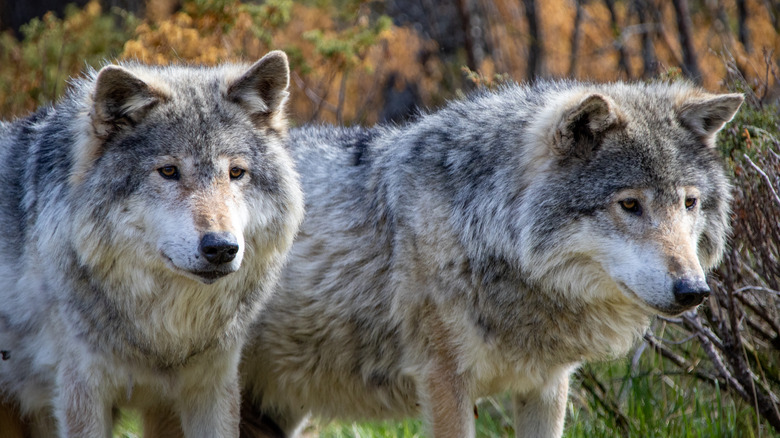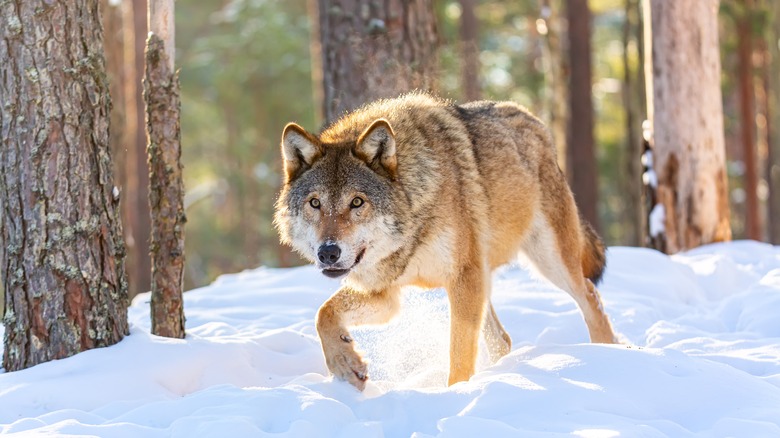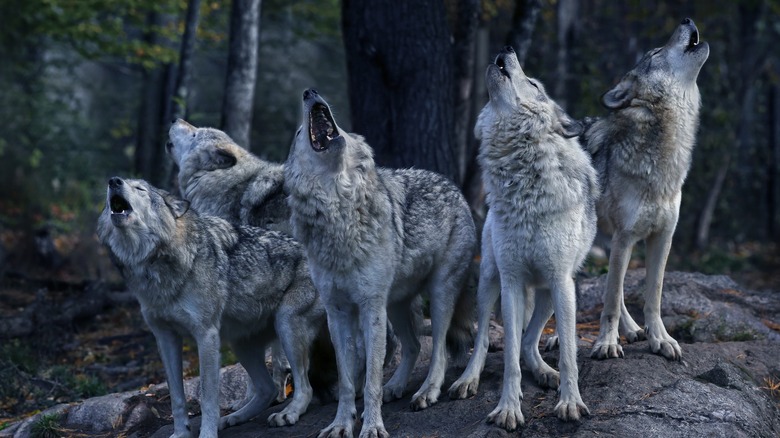How To Avoid A Dangerous Wolf Encounter While Exploring America's National Parks
Few sights are more thrilling than a lone wolf loping with effortless grace through the snowy wilderness. But a recent wolf encounter with tourists in Yellowstone National Park is a reminder of the need for mutual respect between humans and wildlife. According to The Cool Down, a recent Instagram post showed a mass of tourists in Yellowstone getting way too close to a wolf. Watching wolves is an incredible experience and a privilege, but getting too close puts both the person and the animal at risk. One of the main reasons for visiting national parks is a chance to see the variety of wildlife that lives there. With that opportunity comes responsibility, and the safety advice that park rangers recommend should always be followed to avoid potentially dangerous situations.
Yellowstone is one of the best places in the world to see gray wolves. Around 120 wolves currently roam the park in an estimated nine packs. These predators play an important role in the park's ecosystem, helping to control elk populations. When wolves were completely eradicated from Yellowstone in the mid-20th century, it had a negative effect on the other animals in the park. Rampant growth of plant-eating prey, particularly elk, strained the ecology and vegetation throughout the park. The reintroduction of wolves in 1995 was a successful conservation effort, and the wolves soon settled back into their territory. While disease, environmental issues, and territorial disputes influence wolf numbers in Yellowstone, interactions with humans can also play a role. And although the wolves within Yellowstone are protected, unfortunately, those protection laws don't apply outside the park's boundaries.
How to behave around wolves
No matter which park you visit, be cautious in wolf territory. Park rangers provide some important safety advice and recommend following certain precautions to avoid a dangerous wolf encounter. If you happen to cross paths with a wolf, it's essential to keep your distance, no matter how tempting it may be to get in closer for the perfect picture. Rangers advise staying at least 100 yards from wolves. If you get any closer, then not only do you put yourself in danger, but you risk frightening the animals and causing them to react unpredictably. Although wolf attacks are rare, they are fast, powerful animals and should not be underestimated.
Keeping the right distance also means not disturbing the animal. You shouldn't frighten the wolves by shouting, attempting to touch them, or feeding them. Not only is it dangerous, it's against the law. Don't leave any trace of food behind, otherwise, the wolves will learn to associate humans as a food source, making them potentially aggressive and putting both you and the wolf in a risky situation. If a wolf does approach you, retreat slowly backwards. If they act aggressively, you should make as much noise as possible and stand your ground (do not run).
Whether you're in a vehicle or exploring on foot, stick to the designated roads and trails to avoid any surprise encounters. Wolves are intelligent and learn where humans are most active. Inappropriate and careless behavior around wolves has lasting consequences. If the rules are broken and a wolf becomes aggressive, this could lead to the extermination of the wolf, which would be a great loss for both the animal and the ecosystem within the park. You should also learn what to do if you encounter a bison in the wild.
Where to see wolves in the wild
Some of the top spots to see wolves in Yellowstone are in the northern ranges, in particular, Lamar Valley. Taking a guided tour would give you one of the best chances of a wolf encounter. Expert guides know the wolf packs and their territories, giving you the perfect opportunity to get to know more about their habitat and behavior, and why they're so important to the park's ecosystem.
Wolves are generally quite shy and wary of humans, which means sightings aren't as common as you may think. They're more active at dusk and dawn, but winter is the best season to spot them and the best time of year to visit Yellowstone. Their dark coats stand out against the snow, and they tend to be more active during the day in the colder months. They also get more vocal at this time, and from January to March, during the breeding season, you can hear their eerie howls echoing through the park.
Elk make up around 90% of a Yellowstone wolf's diet during the winter, so where there are elk, there are often wolves nearby. Seeing birds circling overhead is also a sign that they are close and they've likely got their eyes on a carcass. Beyond Yellowstone, wolves can also be seen in the Willow Flats in Grand Teton National Park in Wyoming and Denali National Park and Preserve in Alaska.


